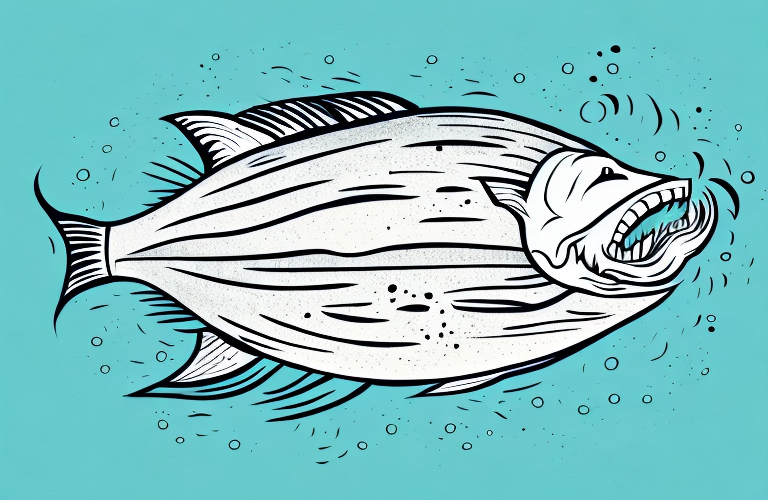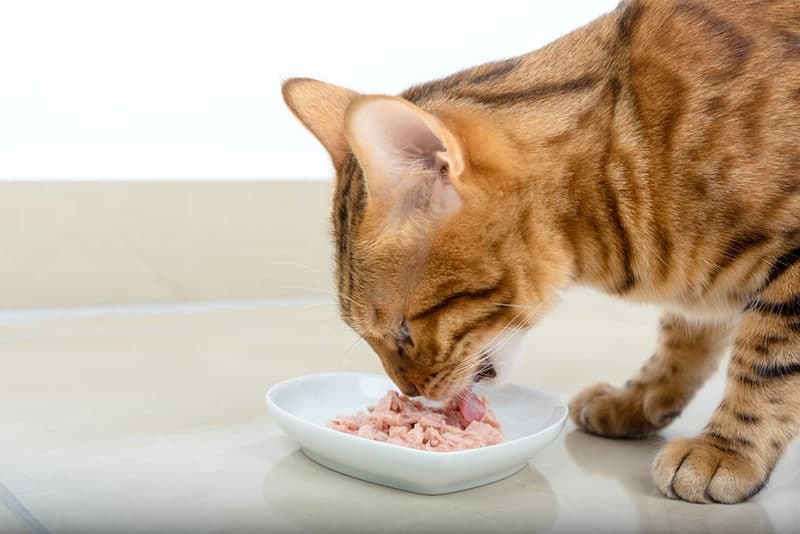It happens to every cat owner sooner or later. As soon as they start to eat their seafood dinner, they feel their cat’s watchful eye on them, begging them to drop something. That’s when they ask themselves one fateful question: Is it safe to serve cooked fish to a cat?.
It turns out that the answer is yes. Cats can eat cooked fish without getting sick. But there are some things you should know before you share your food, so read on before you let your pet finish your flounder.
Can Cats Eat Sea Bass? A Complete Guide for Cat Owners
Sea bass is a popular fish enjoyed by humans in many dishes and cuisines around the world. But is it safe for cats to eat? As a cat owner, you may be wondering if you can share some of your sea bass dinner with your feline friend or if you should avoid giving it to them altogether.
In this comprehensive guide, we’ll cover everything you need to know about cats and sea bass, including the nutritional benefits, potential risks, proper preparation and serving instructions, and suitable alternatives.
What Is Sea Bass?
Sea bass refers to numerous species of fish found in temperate oceans around the world. Some of the most common types of sea bass include European sea bass Chilean sea bass, and black sea bass.
These predatory fish have a mild, sweet flavor that makes them a popular choice for cooking. Sea bass can be baked, grilled, broiled or sautéed and used in everything from tacos and sandwiches to salads, soups and chowders.
Are There Any Nutritional Benefits to Feeding Sea Bass to Cats?
Sea bass contains several nutrients that can benefit cats when consumed in moderation as part of a balanced diet. Some of these nutrients include:
-
Protein – Sea bass is high in protein, which provides energy and supports muscle growth and maintenance. Cats require a diet high in animal protein.
-
Omega-3 fatty acids – These healthy fats support skin, coat, heart, joint and brain health in cats.
-
Vitamins and minerals – Sea bass contains vitamins like B12, A and D as well as minerals like selenium, potassium and phosphorus. These support immune function, vision, bone strength and more.
So in small amounts, sea bass can provide quality nutrition for cats. But there are also some potential risks to be aware of.
What Are the Potential Risks of Feeding Sea Bass to Cats?
While sea bass can make an occasional tasty treat, there are some cautions cat owners should keep in mind:
-
Bones – Sea bass contains small bones that can pose a choking hazard or damage a cat’s digestive tract. Be sure to remove all bones before feeding it to cats.
-
Mercury – Larger sea bass can have higher mercury levels, which can be toxic over time. Avoid feeding cats Chilean sea bass.
-
Allergies – Some cats may be allergic to seafood. Look for symptoms like vomiting, diarrhea or skin irritation.
-
Raw fish dangers – Uncooked sea bass may contain bacteria, parasites or toxins harmful to cats. Always cook thoroughly before feeding.
-
Fat content – The fat in sea bass can lead to pancreatitis or other issues if a cat eats too much. Feed only small amounts.
So while the occasional bite of sea bass is fine, it should not become a regular part of a cat’s diet due to these risks. Moderation is key.
Can Sea Bass Be Part of a Balanced Diet for Cats?
While sea bass can make a healthy, protein-rich occasional treat for cats, it should not be a primary component of their regular, balanced diet. Here’s why:
-
Cats require specific nutrients like taurine and vitamin A that are lacking in sea bass. Their main diet should provide all needed vitamins, minerals and amino acids.
-
Too much sea bass could lead to mercury toxicity over time for cats. Variety is important.
-
Eating the same food too often increases the risk for allergies or sensitivities in cats. Rotating different protein sources is best.
-
Sea bass is not a complete and balanced food source – commercial cat food is formulated specifically to give cats all the nutrients they need.
For optimal feline nutrition, choose a high-quality commercial cat food and use sea bass as no more than 10% of your cat’s total diet. Ask your veterinarian for specific feeding recommendations.
Are There Any Sea Bass Allergies in Cats to Be Aware Of?
As with any new food, it’s possible for cats to be allergic to sea bass. Food allergies and intolerances are actually pretty common in cats. Symptoms may include:
-
Itchy skin or ears
-
Hives or rashes
-
Vomiting/diarrhea
-
Respiratory issues like coughing or wheezing
-
Swelling of the face/lips
If you notice any of these reactions after feeding your cat sea bass, stop giving it immediately and contact your veterinarian. They can help identify allergy triggers and provide treatment guidance.
The best way to avoid allergies is to introduce new foods slowly and look for any negative effects. Every cat is an individual, so watch yours closely when first trying sea bass.
Tips for Safely Preparing and Serving Sea Bass for Cats
Follow these tips for safely feeding sea bass to cats:
-
Choose wild-caught, low-mercury varieties like black sea bass. Avoid Chilean sea bass which is high in mercury.
-
Cook sea bass thoroughly – bake, broil, grill or poach it to eliminate any parasites or bacteria. Never feed raw.
-
Remove all bones, which could injure a cat’s mouth or digestive tract. Also take out skin which is difficult to digest.
-
Use plain, unseasoned preparations without garlic, onions, salt or other ingredients harmful to cats.
-
Cut the sea bass into bite-sized pieces for easy eating. Shred or mash for kittens.
-
Limit to a few small bites of sea bass 1-2 times per week at most, as part of a balanced cat diet.
When in doubt, check with your veterinarian about the best way to incorporate sea bass into your cat’s meal plan. Follow proper handling procedures to reduce risks.
Healthy Fish Alternatives to Try for Cats
If you want to occasionally feed fish to your cat but are concerned about sea bass, there are some safer alternatives:
-
Flaked canned tuna – Choose low sodium varieties and limit intake to reduce mercury exposure.
-
Salmon – Wild-caught salmon is high in omega-3s but lower in mercury than tuna.
-
Catfish – Farm-raised catfish makes a good hypoallergenic option, since many cats are allergic to different types of fish.
-
Sardines – These small fish are low in mercury and packed with nutrients. Look for low-sodium canned sardines packed in water.
As always, introduce new fish slowly and limit total fish intake to less than 15% of your cat’s diet, per vet recommendations. Variety is key!
The Verdict on Cats and Sea Bass

Is Cooked Fish Safe for Cats?
You would think that you should only feed raw fish to your cat. After all, they’ve spent thousands of years catching and eating the things out in the wild. As it turns out, cooked fish is much safer for cats than raw fish. Raw fish can cause an upset stomach in your feline friend, and that’s if you’re lucky. Also, some fish, like tuna, can be high in mercury and other pollutants that are bad for the environment. It can carry worms or bacteria that could be very harmful to your pet.
There’s also a compound called thiaminase in raw fish. Thiaminase interferes with your cat’s ability to process thiamine, an essential B vitamin. If your cat doesn’t get enough thiamin, they could suffer a host of neurological problems, including convulsions and even death.
Note: Cats should not be fed raw fish (even if they are on a raw diet).
That doesn’t mean that there aren’t dangers lurking inside cooked fish, however. The biggest one is fish bones. It’s possible for a stray bone to get stuck in your cat’s throat or digestive tract and cause them a lot of pain or even death.

Note: Make sure all the bones have been safely taken out of any fish you give your cat before giving it.
Fish Is Healthy for Cats, Though, Right?
Certain types of fish can be healthy for cats, yes. If you don’t want to give your cat too much tuna or tilefish (also called “ocean whitefish”), these are the fish that are most likely to be contaminated.
Also, some cats are allergic to fish. If you notice that your cat scratches a lot, gets skin or ear infections more often, or has stomach problems after eating fish, they may not be able to handle it. Stop giving it to them and see if the troubling signs disappear. Consult with your veterinarian to confirm a suspected food allergy to avoid mishaps in the future.
Assuming the fish that you’re feeding your cat is safe and they can process it, fish has important health benefits for kitties. It’s high in lean protein, and they’ll get plenty of muscle-building amino acids without packing on excess weight in the process. Fish is an excellent source of fish oil, which is loaded with omega fatty acids. These are valuable antioxidants that do everything from fighting inflammation to helping keep your cat’s coat shiny and glossy.
Beyond that, many cats simply love the taste. If you have a picky eater, you might be able to get them to eat all of their kibble by adding some cooked fish or just the oil from the fish.
It’s not always safe to feed your cat human food, but we have a way for you both to stay happy.
Weve currently got a 40% discount to share on the HUMAN-GRADE premium cat food that ranked number #1 in our reviews! CLICK HERE & use code Catster24 to SAVE 40% on Smalls cat food!
Should I Feed Fish to my Cat? Is It SAFE? | Cat Nutrition Guide 101
FAQ
Can cats eat cooked seabass?
Can cats eat sea fish?
Is Bass good for cats?
Can cats eat fish?
On the negative side, some kinds of fish can also destroy certain vitamins. So, feeding fish to cats is a bit of a science, if nutritional balance is to be achieved. Another problem for cat owners is that cat food that has a lot of fish in it, frankly, smells horrible and can linger! Thankfully that’s where technology can lend a helping hand.
Can cats eat cooked seafood?
The short answer is that cats can eat seafood occasionally, but serious considerations must be made. Is Cooked Seafood Safe for Cats? When thoroughly cooked and properly prepared, cats can safely eat a small amount of seafood like fish occasionally.
Can cats eat fish & fish oil?
Yes, cats can eat commercial foods that contain fish and fish oil in the ingredients. These foods are specially formulated to include any supplements necessary to balance the vitamins and minerals and ensure that deficiencies do not develop.
Can cats eat fish without thiaminase?
Fish that are thiaminase-free include: Though it’s tempting to give cats human foods, healthy cats on a high-quality, well-balanced diet should limit their intake of fish to once a week. Repeatedly feeding cats raw fish can adversely affect their health by depleting them of B vitamins.
